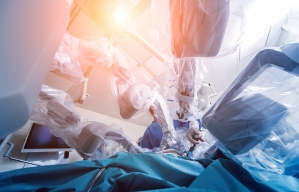Robotic-Assisted Surgery: Providing Patients with More Options
Medically Reviewed by John W. Sonfield, MD
From an interview with
Dr. John Sonfield
Pee Dee Surgical Group
While surgery heals and restores the body, many patients still have concerns about the pain and challenges of recovery they may face after surgery. By using robotic-assisted, laparoscopic, and minimally-invasive surgical techniques, surgeons can both rehabilitate the body and reduce pain, easing patients’ fears and apprehension. Dr. John Sonfield, a general surgeon with Pee Dee Surgical Group, explains the many benefits these modern-day technologies offer for health and healing.
“Robotic-assisted surgery can provide extra benefits to both surgeons and patients. McLeod surgeons use leading-edge technology to perform the latest invasive and non-invasive techniques and procedures to provide the highest quality of surgical services to patients. Using these advanced technologies, including robotic assistance, the specially trained general surgeons at McLeod Health perform a wide range of complex surgical procedures, including hernia repair, gallbladder removal, colon removal, and surgery for reflux disease.
Robotic-assisted surgery is a form of minimally invasive surgery where surgeons use a computer-controlled robot to assist in certain surgical procedures. Thanks to the robotic technology, surgeons can perform many types of complex procedures with greater visibility, flexibility and control than possible when performing surgery using traditional techniques.
This is a human-driven operation. During surgery, the surgeon controls the robot’s every move while seated at a console in the operating room. The surgeon views the surgical site through high-definition, magnified, 3-D imagery that provides improved precision and visualization. The surgeon’s hand, wrist and finger movements guide the robot as it becomes an extension of the surgeon’s hands, allowing the surgeon to work in a very small space with tremendous precision and agility.
Like minimally invasive surgery or laparoscopic surgery, robotic-assisted surgery is performed through a few small incisions and provides many benefits to the patient including:
- Less pain
- Smaller incisions
- Less blood loss
- Reduced risk of infection
- Minimal scarring
- Shorter hospital stay
- Faster recovery
- Quicker return to normal activities
Another added benefit of these advanced surgical technologies is that they have changed the way doctors prescribe post-operative pain killers. Post-operative prescriptions are usually meant to be used only for a short period of time, so pain expectations are discussed with patients ahead of surgery. Since robotic-assisted and laparoscopic surgery causes less internal trauma than traditional open surgery, and leads to less pain, shorter hospital stays, and easier recoveries, prescriptions for post-op patients are needed less frequently. In fact, many patients may only need ibuprofen after minimally invasive robotic and laparoscopic surgery. Less pain medication after surgery helps reduce the chance of addiction and helps address the overall opioid crisis. Minimally invasive robotic-assisted surgeries, combined with smaller prescriptions, reduces both first-time opioid use and the number of pills prescribed.”
Like minimally invasive surgery, robotic-assisted surgery is not for everyone. Talk with a surgeon near you about your condition to determine the surgical option that’s right for you.
-
McLEOD REGIONAL MEDICAL CENTER FLORENCE
843-777-2000 -
McLEOD DARLINGTON
843-777-1100 -
McLEOD DILLON
843-774-4111 -
McLEOD LORIS
843-716-7000 -
McLEOD SEACOAST
843-390-8100 -
McLEOD CHERAW
843-537-7881 -
McLEOD CLARENDON
803-433-3000



-
McLEOD REGIONAL MEDICAL CENTER FLORENCE
843-777-2000 -
McLEOD DARLINGTON
843-777-1100 -
McLEOD DILLON
843-774-4111 -
McLEOD LORIS
843-716-7000 -
McLEOD SEACOAST
843-390-8100 -
McLEOD CHERAW
843-537-7881 -
McLEOD CLARENDON
803-433-3000
 Find a Doctor
Find a Doctor  Locations
Locations  Services
Services 